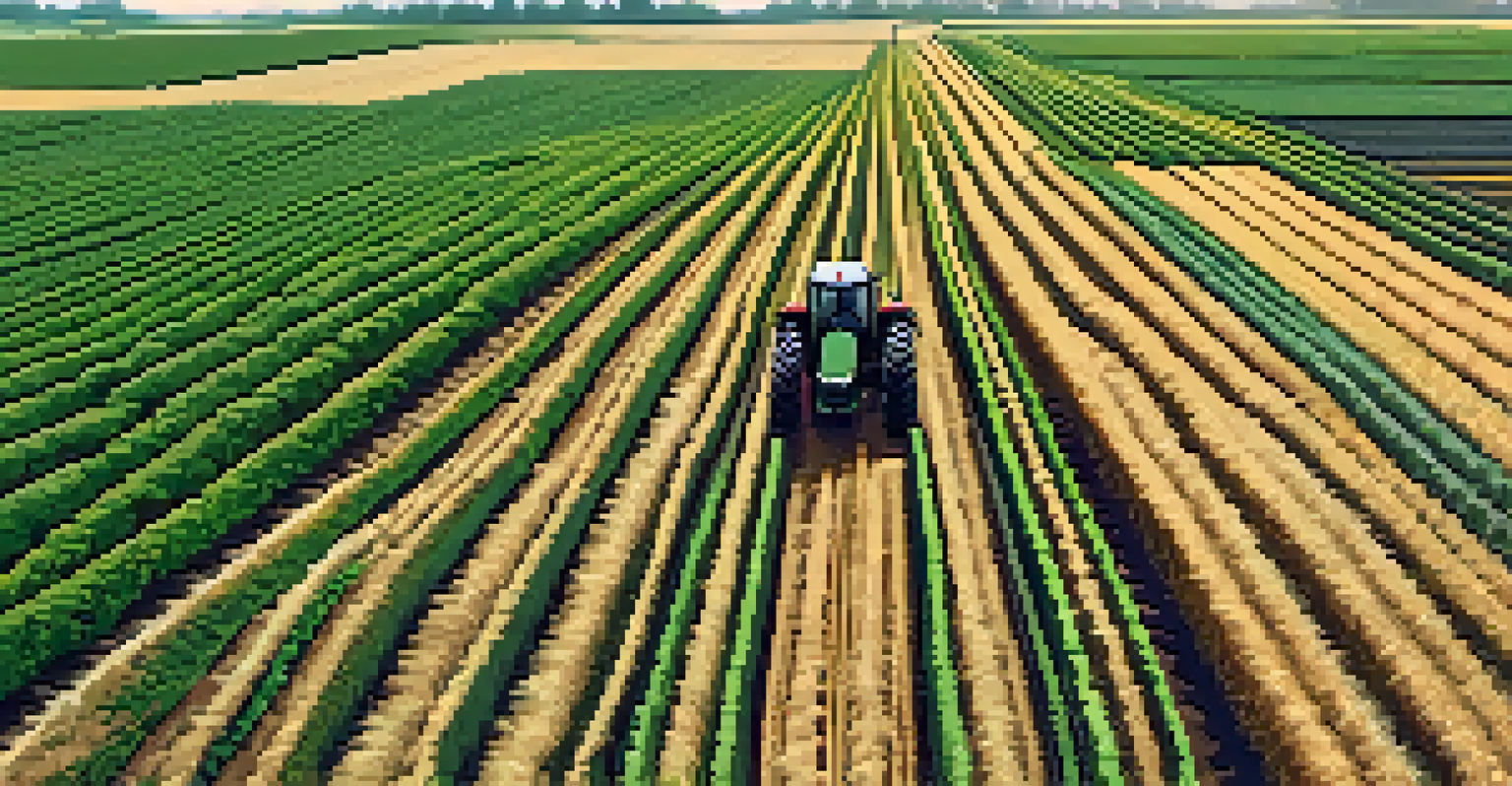Crop Rotation: A Strategy for Better Soil Management

Understanding Crop Rotation and Its Benefits
Crop rotation is the practice of growing different types of crops in the same area across a sequence of seasons. This strategy not only helps in maximizing the productivity of the soil but also reduces the dependency on chemical fertilizers. By alternating crops, farmers can create a more balanced ecosystem that promotes healthy soil and plant growth.
Crop rotation is a fundamental practice that can help improve soil health and crop productivity.
One of the primary benefits of crop rotation is its ability to prevent soil depletion. Different crops have varying nutrient requirements, which means that rotating them allows the soil to recover its nutrient levels over time. For instance, legumes like beans or peas can fix nitrogen in the soil, enriching it for future crops.
Moreover, crop rotation helps in managing pests and diseases naturally. By changing the types of crops grown in a particular field, farmers can disrupt the life cycles of pests and pathogens that thrive on specific plants. This natural pest management leads to healthier crops and reduces the need for chemical pesticides.
How Crop Rotation Improves Soil Fertility
Soil fertility is crucial for crop production, and crop rotation plays a vital role in maintaining it. Different crops have different root structures and depths, which means they access various soil layers for nutrients. For example, deep-rooted plants can access nutrients that shallow-rooted crops cannot, leading to a more sustainable nutrient cycle.

Additionally, rotating crops can help improve soil structure and prevent erosion. When the same crop is grown repeatedly, it can lead to compacted soils and reduced organic matter. On the other hand, alternating crops encourages a diverse root system, which helps aerate the soil and promote better water infiltration.
Crop Rotation Boosts Soil Health
By alternating different crops, farmers can enhance soil fertility and prevent nutrient depletion.
Incorporating cover crops into rotation can further enhance soil fertility. These crops, often planted during off-seasons, help prevent soil erosion, improve organic matter, and boost microbial activity, which is essential for nutrient cycling. This holistic approach ensures the soil remains rich and productive.
The Role of Crop Rotation in Pest Management
Pest management is a significant concern for farmers, and crop rotation serves as an effective strategy in this regard. By rotating crops, farmers can disrupt the habitat of pests that are specific to certain plants, reducing their populations naturally. This practice minimizes the reliance on chemical pesticides, resulting in a healthier ecosystem.
Diversity in crop production is key to sustainable agriculture and pest management.
For instance, if a farmer grows corn in a field one year and then rotates to soybeans the next, pests that thrive on corn will find it challenging to survive without their preferred food source. This not only keeps pest populations in check but also encourages beneficial insects that prey on harmful pests.
Moreover, crop rotation can help in managing diseases that affect specific crops. Many plant diseases are host-specific, meaning they can only survive on certain plants. By rotating crops, farmers can break the disease cycle, allowing the soil to recover and reducing the likelihood of outbreaks in future planting seasons.
Selecting Crops for Effective Rotation
Choosing the right crops for rotation is essential for maximizing benefits. Farmers should consider the nutrient needs of each crop, their growth habits, and their susceptibility to pests and diseases. For example, following a heavy feeder like corn with a nitrogen-fixing crop like legumes can significantly improve soil health.
It's also crucial to consider the seasons and local climate when planning crop rotations. Some crops thrive in cooler months, while others prefer warmer temperatures. By selecting crops that complement each other and suit the local environment, farmers can optimize their yields and maintain soil fertility.
Natural Pest Management Benefits
Crop rotation disrupts pest life cycles, reducing the need for chemical pesticides and promoting a healthier ecosystem.
Furthermore, incorporating a mix of annual and perennial crops can enhance biodiversity on the farm. This diversity not only benefits the soil but also attracts a variety of pollinators and beneficial insects, creating a more resilient ecosystem.
Challenges of Implementing Crop Rotation
While crop rotation offers numerous benefits, it does come with challenges that farmers must navigate. One significant hurdle is the need for knowledge and planning. Farmers must understand how different crops interact with one another and the specific requirements of each to create an effective rotation plan.
Additionally, market demands can pose a challenge. Farmers may feel pressured to grow high-demand crops consistently, limiting their ability to rotate. However, it's essential to balance market needs with sustainable practices for long-term soil health.
Lastly, some farmers may face logistical challenges, such as the availability of equipment and resources needed for diverse crop management. Overcoming these obstacles often requires support from agricultural extension services and collaborative efforts among farmers.
The Environmental Impact of Crop Rotation
Crop rotation is not just beneficial for farmers; it also has positive implications for the environment. By reducing the need for chemical fertilizers and pesticides, crop rotation contributes to cleaner air and water. Less chemical runoff means healthier ecosystems and wildlife.
Additionally, rotating crops can enhance biodiversity on farms. A diverse range of crops can support various species of flora and fauna, promoting a more balanced ecosystem. This biodiversity is crucial for maintaining soil health and resilience against pests and diseases.
Environmental Advantages of Rotation
Implementing crop rotation contributes to cleaner air and water, enhances biodiversity, and aids in carbon sequestration.
Moreover, crop rotation can help in carbon sequestration. By improving soil health and increasing organic matter, more carbon is stored in the soil, contributing to climate change mitigation. In this way, crop rotation serves as a sustainable practice that supports both agriculture and environmental stewardship.
Implementing Crop Rotation: Tips for Success
To successfully implement crop rotation, farmers should start by assessing their current soil health and crop productivity. Understanding the specific needs of the soil will help in designing an effective rotation plan. Soil testing can provide valuable insights into nutrient levels and deficiencies.
Next, creating a detailed plan is essential. Farmers should outline which crops will be planted in each season and consider factors such as growth time, nutrient needs, and market demand. Keeping a rotation schedule can help in tracking progress and making adjustments as needed.

Lastly, seeking advice from agricultural experts and collaborating with fellow farmers can provide additional support and insights. Sharing experiences and learning from each other can help in overcoming challenges and maximizing the benefits of crop rotation for sustainable soil management.